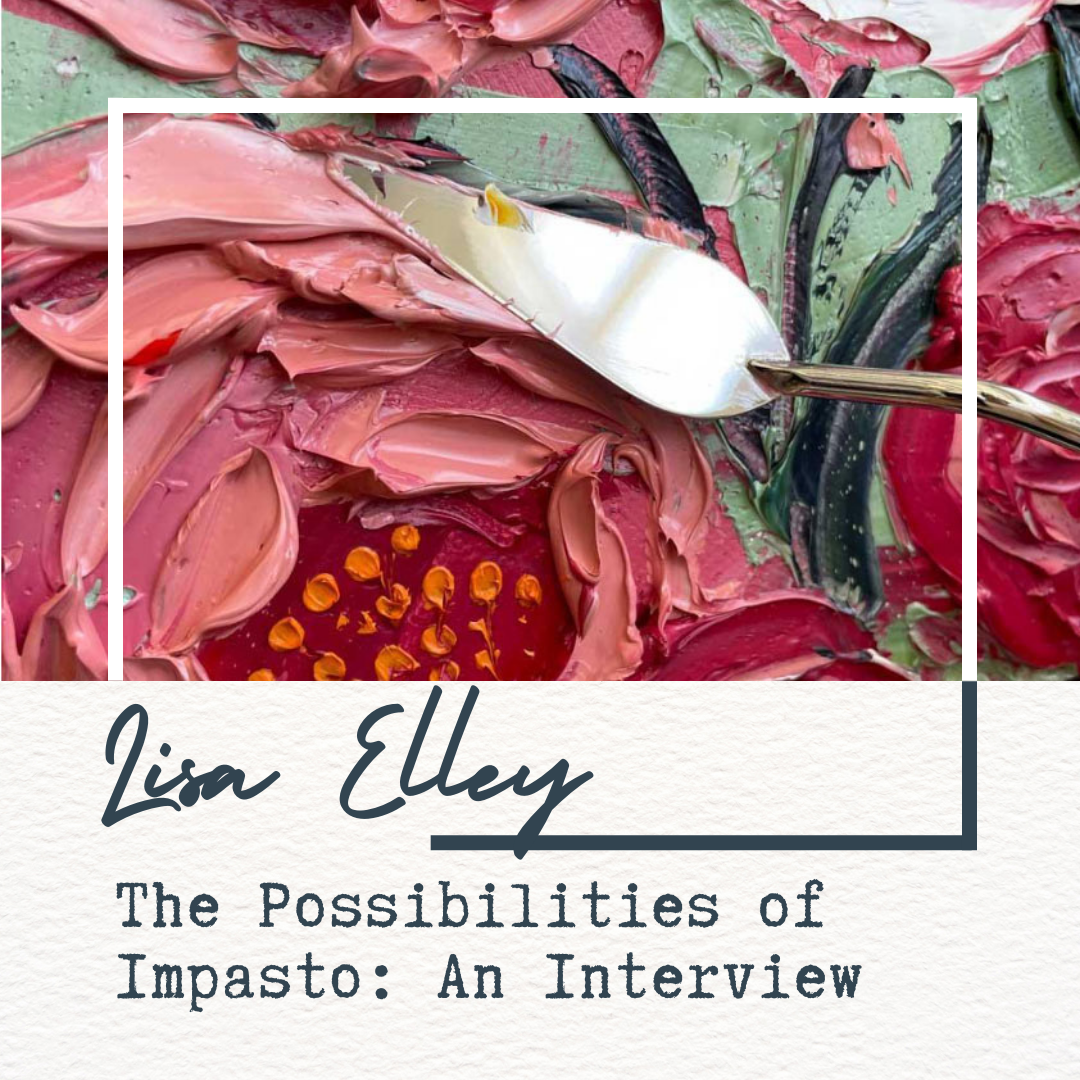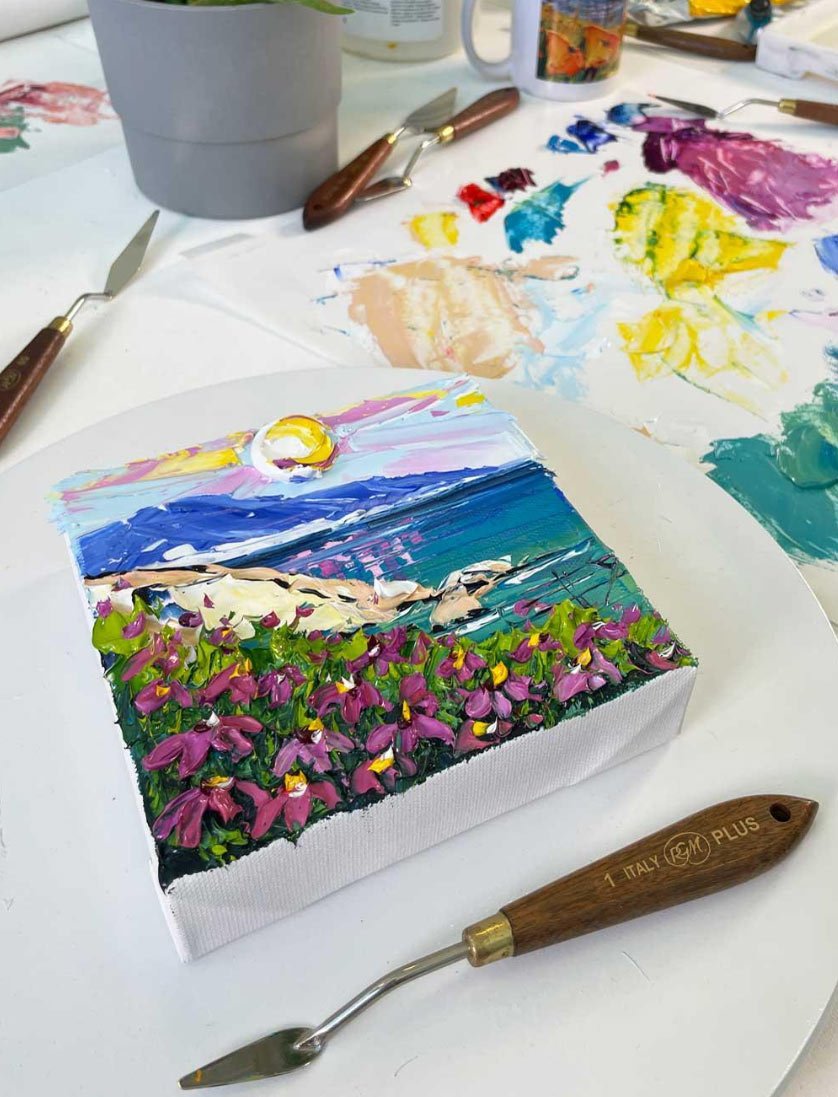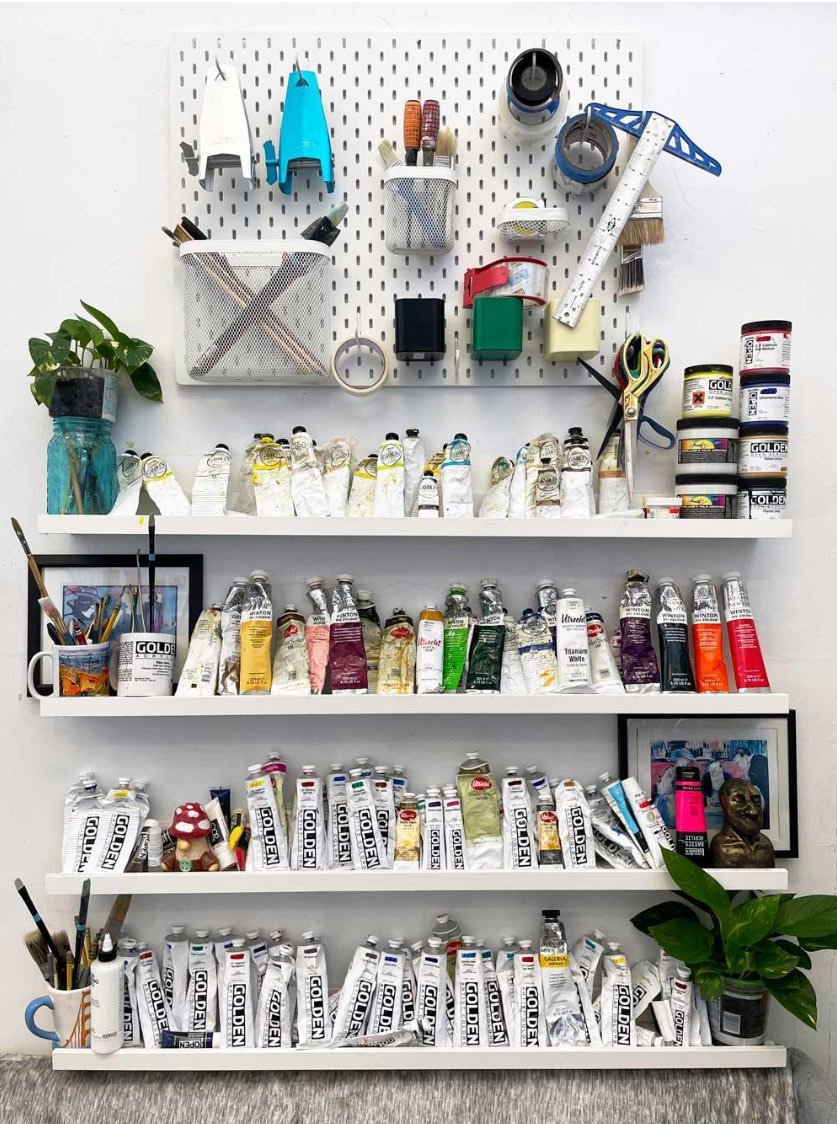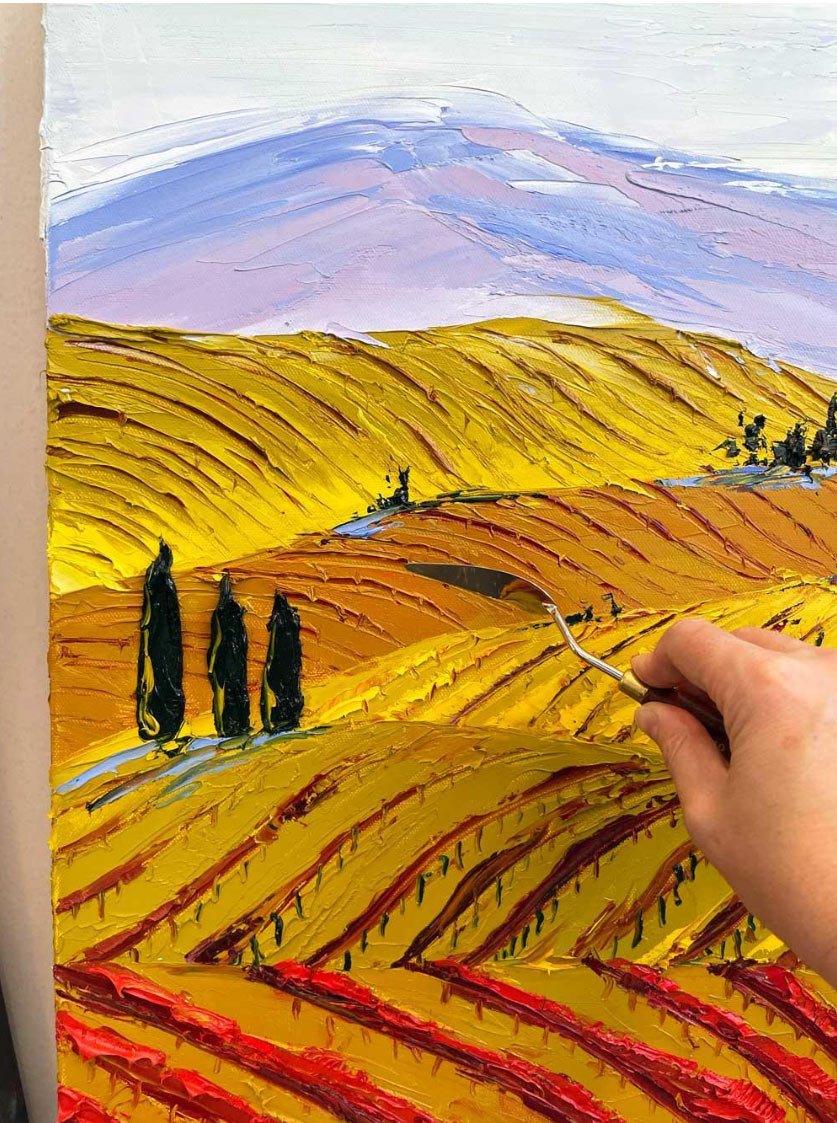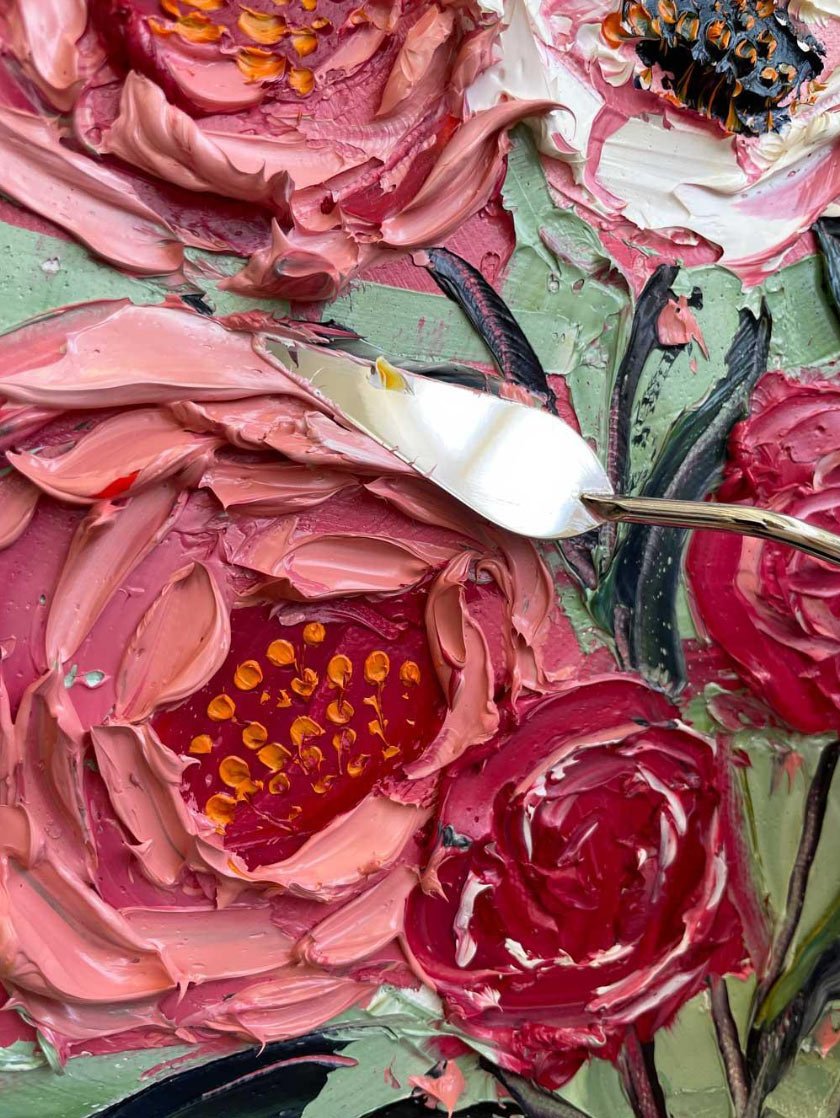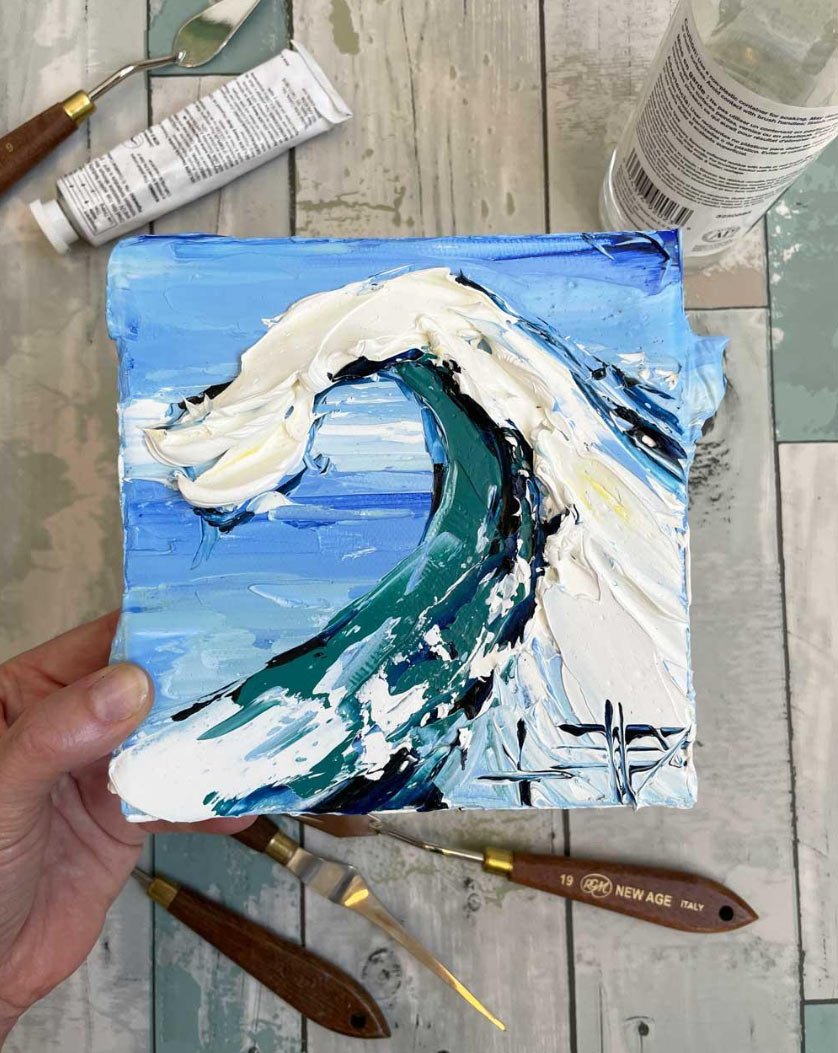The Possibilities of Impasto: An Interview with Lisa Elley
Check out Lisa Elley’s NEW book “Palette Knife Painting: Deep Impasto.” Learn more and save 35% at quarto.com/deepimpasto when you click “add to basket” and use coupon code IMPASTO now through June 30.
What does your deep impasto style give you as an artist that other ways of working don’t give you?
As an artist, my deep impasto style is very important to me as it allows me to create a really unique sense of texture and depth in my artwork. By using thick layers of paint to create a three-dimensional image on the canvas, I can create a tactile experience for the viewer that almost feels tangible. People often comment that they want to touch, taste and smell my paintings, and involving the senses feels more dynamic and exciting.
Using the impasto technique allows me to take a more expressive and spontaneous approach to painting. The thick strokes of paint can be placed and moved around on the canvas, giving me more freedom to explore my creativity and create a sense of movement and energy in my artwork. This reflects my personality, and feels natural and satisfying.
So overall, my deep impasto style is integral to my artistic process as it gives me a really unique visual and tactile experience in my artwork. It allows me to create a more expressive and dynamic piece that really stands out from other painting styles.
What paints do you use for deep impasto? Are there any paints an artist should avoid for this style?
You can use either oil or acrylic paints for deep impasto. In my new book Palette Knife painting; Deep Impasto I demonstrate with oil, as it’s my most used medium. I also occasionally use acrylic, as it has a faster dry time, and is convenient when I have a time sensitive piece, such as a commission or piece for a gallery that is required fast.
Acrylic dries very quickly, so you’ll have to work very fast. You will also need to use some kind of thickening medium, such as molding paste or modeling paste, as well as at least medium to heavy body viscosity paint. You can’t use fluid paint, as there is no way to build up texture and to retain the peaks. Acrylic also is harder to blend, relaxes a little as it dries, and changes color somewhat as it dries. The upside is the fact that your extremely textured painting is dry in a few days.
“By using thick layers of paint to create a three-dimensional image on the canvas, I can create a tactile experience for the viewer that almost feels tangible.”
-Lisa Elley
Oil is slower drying, so there’s less pressure to complete a piece quickly. It has a natural buttery feel, is easier to blend, and there is no medium required, you can just use the paint straight from the tube without adding anything for bulk. If you want to add a medium to try and speed up the dry time, or add stability and flexibility, you can add Impasto medium.
Whether you choose oil or acrylic, try to avoid cheap paints with a low pigment concentration, as they tend to be thinner and may crack and not hold up well in thick impasto layers.
How is a palette knife different from a brush? What does it allow you to do in your work that maybe a brush doesn’t?
A palette knife is different from a brush in several ways. Unlike a brush that has bristles that are used to apply paint in a smooth and controlled manner, a palette knife has a flat or rounded metal blade that can be used to apply paint in thick, textured layers.
The use of a palette knife gives me greater control over the application of paint, enabling me to create more dramatic and varied textures in my work. The shape and size of the blade can be changed to create different effects, from fine lines and sharp edges to broad strokes and blended areas.
I have a large selection of knives in my studio, and part of the enjoyment of my process is selecting a blade for whichever effect I am working on.
Another advantage of using a palette knife is that it can be used to mix colors directly on my canvas, allowing for more spontaneous and intuitive color choices. It can also be used to scrape away layers of paint, or to add additional layers on top of existing ones.
Overall, a palette knife offers me more freedom and versatility in my approach to applying paint, allowing for greater control over texture and the ability to mix colors directly on the canvas. It also gives me a playfulness and abandon that I really enjoy in my creative process.
Could you walk us through your process?
As an artist, my inspiration for my artwork comes from the natural beauty of the world around me, particularly landscapes, seascapes, and flowers. To capture my initial ideas, I take lots of photographs and also make sketches in the field. I spend a lot of time outdoors, observing, searching for vistas, analyzing composition, and just breathing in my surroundings. I take a lot of walks, drive to parks & the beach, people watch in cafes, go wildflower hunting, and just observe any area or situation that is interesting and that captures my attention.
Once I have gathered inspiration, I sometimes watercolor sketch my ideas into a watercolor paper journal, adding some black ink line work. With my smaller paintings, I don’t typically sketch or paint a brush study first with oil paints, preferring to start directly on to my canvas with my palette knives. I find that sketching on to the canvas can be a little pointless with thick impasto painting, as it gets very quickly painted over, and adds another unnecessary step.
When I do occasionally feel like using a brush, it's usually on a bigger piece, where I will sketch an underpainting onto the canvas using thin layers of paint. This layer serves as a foundation for the following layers of thick impasto paint.
“Overall, a palette knife …gives me a playfulness and abandon that I really enjoy in my creative process.”
-Lisa Elley
Using a palette knife, I then begin building up thick layers of paint in a three-dimensional texture, which allows me to create a tactile experience for the viewer and adds depth and dimension to the painting.
Once the impasto layers are finished, I step back and take some time to observe the piece. It’s a good idea to leave the room for a while here, to add fresh perspective. I then add the finishing touches to my artwork, including highlights, shadows, and details, to create a touch of whimsy, and to make certain areas really pop. I also prevent myself from fiddling with it! It can be so tempting to jump back in and tweak things, but really once you’ve captured the essence of your subject matter, adjusting things just doesn’t do much, especially with thick impasto, as it’s easy to fiddle with it and ruin the gestural effect.
After completing the painting, I allow it to dry completely before varnishing it to protect the painting from dust and UV damage. This can take many months with thick oil paint. If I’m shipping it out, and don’t have time to wait months for it to dry completely, I may add a retouch varnish, which is a lighter varnish, giving the oil paint the opportunity to ‘breathe’ and dry more.
What kind of planning do you do before you start with paint? Any decisions you need to have made before you get started?
Before starting with paint, I typically do some planning and decision-making, mostly mentally. I consider the subject matter, composition, color palette, and overall style of the painting. I make sure my subject matter resonates with me, pick a couple of main complementary colors, and decide where my focal point and main composition will sit on the canvas. I also choose the size and orientation of the canvas. I ask myself, is this canvas size a good fit for the composition?
Squeezing too much onto a small canvas is a common mistake, especially with thick impasto, so often a portion of a landscape is a better choice, versus the entire sweeping vista.
If I’m working on a larger piece, I will also plan out any underpainting or preparatory layers that will serve as a foundation for the subsequent layers of paint.
I also think about the tools I will use, such as a very large palette knife to block in the sky or other large areas of paint.
I also consider the level of detail or abstraction. Am I going for a realistic painting, or more of an abstract? This often depends on my subject matter. A moody and atmospheric foggy day will lend itself to more of an abstract feel, versus crisp and clear realism.
Making these decisions beforehand can really help guide my process, and create a clear direction for the artwork.
Your paintings are so wonderfully bright. How do you make color choices? Is that based on exactly what you see in your reference or do you look for ways you can push the colors?
I make color choices in a variety of ways, depending on my artistic vision and the specific painting I am creating.
Sometimes I start with a basic color palette based on my reference material, but then look for ways to push and enhance the colors to create a more vibrant and dynamic painting.
Palette knife painting is a color blocking technique, so bright and saturated colors will pop more than subdued tones.
I rely on my intuition and personal taste to choose colors that feel right for the composition.
I also use basic color theory principles to create a harmonious or contrasting color scheme, such as the two complimentary colors of red and green for the dominant palette on a vineyard inspired piece.
Ultimately, my color choices are influenced by a combination of factors, including the subject matter, personal style, artistic vision, and the emotional response I want to evoke in the viewer.
Combined with this is always playfulness, and paintings often just take on a life of their own!
How deliberate are you going into an area about what kind of textures you want there. Could you give an example?
I’m usually quite intentional with my texture placement. A palette knife painting looks more dynamic when some areas are less textured. For example; a blue sky with a more painterly feel to it looks amazing with thick palette knife silver birch or aspen tree trunks placed over the top, and then increasing the texture even further with colorful fall foliage applied as dots with the tip of the palette knife.
With a still life painting, I like to make the background less textured, then building up the texture with the foliage, and finally the flower petals are always the thickest, which gives them an amazing 3D quality where they just leap off the canvas! Thickly textured pink peony petals look amazing over a smoother green background, and really pop quite dramatically.
When someone is getting started with deep impasto, do you suggest they work on exercises or learn through finishing paintings? Why?
When getting started with deep impasto, I recommend learning through daily finished paintings. Impasto painting is a wet-on-wet technique, as well as ‘Alla Prima’, meaning all in one go. Paint is expensive too, another reason to finish a painting!
Skill acquisition requires repetition, and daily painting of a smaller piece will really fill your cup both creatively, as well as hone your skill. It doesn’t take long to finish one 6”, 8” or 8x10” painting, and my approach has always been to carve out the time, keep the paints accessible, have a journal or list of painting ideas and images ready to go, make yourself a cup of tea or coffee, and off you go.
No procrastinating here, it’s just a painting, and if you don’t like it, tomorrow's one will most likely be better.
You will find after one year of doing this, you will feel very natural handling the knife, will have formed your own unique style, and will also have a fantastic body of work!
What is the biggest challenge you see students face with impasto and what advice do you give them?
One of the biggest challenges for students may be achieving the right balance of thickness and texture in their paint application.
Too much paint can cause the painting to lose depth and definition, with the student losing control of the knife and the paint placement. Feeling out of control, frustrated, and then giving up is what we’re trying to avoid!
Too little paint on the other hand, and being too tentative may not create the desired texture or depth. There is a sweet spot here with the texture, which can be achieved by lots of practice, which will lead to an inevitable feeling of confidence.
“No procrastinating here, it’s just a painting, and if you don’t like it, tomorrow's one will most likely be better.”
-Lisa Elley
My advice here is to commit to daily painting. Keep the paints out in a dedicated area, and aim for 30 or 40 minutes, 5x a week. Don’t have space? Me neither at first! I’ve painted at the kitchen table, counter, desk, patio, bedroom nightstand, and even in bed! (as did Matisse & Frida Kahlo, amongst others)
Palette knife painting is harder than it looks, and feeling comfortable and confident with a knife can be achieved with repetition, plenty of fails, experimenting with what feels right for you, and remembering that it should be fun above all!
Check out Lisa Elley’s NEW book “Palette Knife Painting: Deep Impasto.” Learn more and save 35% at quarto.com/deepimpasto when you click “add to basket” and use coupon code IMPASTO now through June 30.

